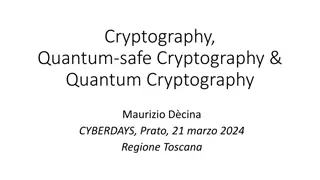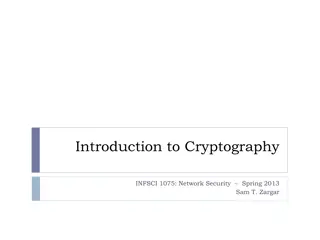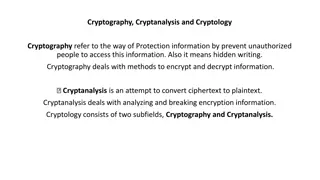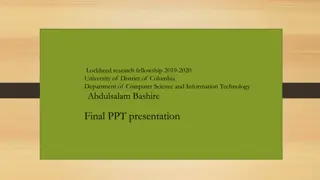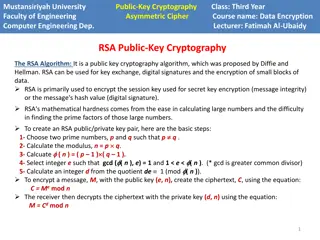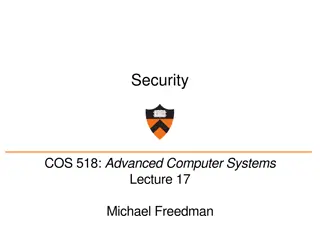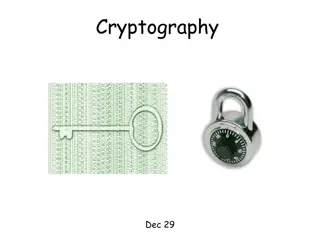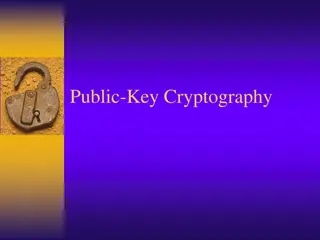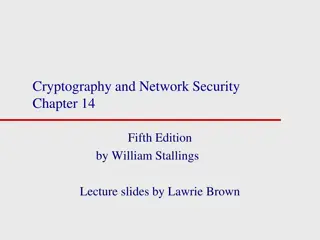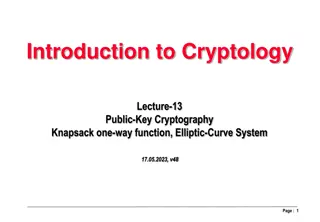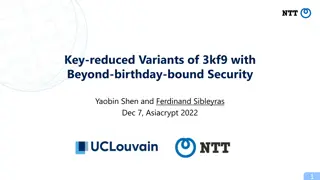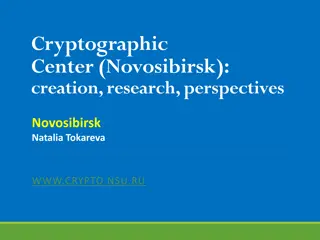
Introduction to Cryptography: Understanding the Art of Secret Writing
Explore the world of cryptography with "Introduction to Cryptography" by Joe McCarthy, covering topics such as the art of secret writing, breaking encryption schemes, types of cryptographic functions, secret key and public key cryptography, hash algorithms, network security, and more. Learn about the key players in cryptography, computational issues, and the importance of using efficient algorithms for securing information.
Download Presentation

Please find below an Image/Link to download the presentation.
The content on the website is provided AS IS for your information and personal use only. It may not be sold, licensed, or shared on other websites without obtaining consent from the author. If you encounter any issues during the download, it is possible that the publisher has removed the file from their server.
You are allowed to download the files provided on this website for personal or commercial use, subject to the condition that they are used lawfully. All files are the property of their respective owners.
The content on the website is provided AS IS for your information and personal use only. It may not be sold, licensed, or shared on other websites without obtaining consent from the author.
E N D
Presentation Transcript
Introduction to Cryptography Joe McCarthy
Outline 2. Introduction to Cryptography. What Is Cryptography? Breaking an Encryption Scheme. Types of Cryptographic Functions. Secret Key Cryptography. Public Key Cryptography. Hash Algorithms. Network Security: Private Communication in a Public World, 2/E Charlie Kaufman Radia Perlman Mike Speciner CSS 432: Introduction to Cryptography
Cryptography The art of secret writing. The art of mangling information into apparent unintelligibility in a manner allowing a secret method of unmangling. CSS 432: Introduction to Cryptography
Cryptography Definitions Messages: Plaintext Ciphertext Ingredients: Algorithm(s) Key(s) Players: Cryptographer: invents clever algorithms Cryptanalyst: breaks clever algorithms CSS 432: Introduction to Cryptography
Cryptography Algorithm Key(s) = secret value(s) OK for good algorithm to be public Not OK to use bad algorithm Sunlight is the best disinfectant Algorithm without key does not help unmangle the information CSS 432: Introduction to Cryptography
Computational Issues Algorithm should be reasonably efficient Security depends on how hard it is to break Combination lock 3 number sequence (2R, 1L, 0R), #s between 1-40 Possible combinations: CSS 432: Introduction to Cryptography
Computational Issues Algorithm should be reasonably efficient Security depends on how hard it is to break Combination lock 3 number sequence (2R, 1L, 0R), #s between 1-40 Possible combinations: 403 = 64,000 10 seconds per sequence: 178 hours (/ 2 = 89) CSS 432: Introduction to Cryptography
Computational Issues Algorithm should be reasonably efficient Security depends on how hard it is to break Combination lock 3 number sequence (2R, 1L, 0R), #s between 1-40 Possible combinations: 403 = 64,000 10 seconds per sequence: 178 hours (/ 2 = 89) CSS 432: Introduction to Cryptography
Computational Issues Algorithm should be reasonably efficient Security depends on how hard it is to break Combination lock 3 number sequence (2R, 1L, 0R), #s between 1-40 Possible combinations: 403 = 64,000 10 seconds per sequence: 178 hours (/ 2 = 89) 4 number sequence, 13 seconds per sequence CSS 432: Introduction to Cryptography
Computational Issues Algorithm should be reasonably efficient Security depends on how hard it is to break Combination lock 3 number sequence (2R, 1L, 0R), #s between 1-40 Possible combinations: 403 = 64,000 10 seconds per sequence: 178 hours (/ 2 = 89) 4 number sequence, 13 seconds per sequence 404 = 2,560,000 9,244 hours CSS 432: Introduction to Cryptography
Computational Issues Algorithm should be reasonably efficient Security depends on how hard it is to break Combination lock 3 number sequence (2R, 1L, 0R), #s between 1-40 Possible combinations: 403 = 64,000 10 seconds per sequence: 178 hours (/ 2 = 89) 4 number sequence, 13 seconds per sequence 404 = 2,560,000 9,244 hours CSS 432: Introduction to Cryptography
Publication Issues Public or secret algorithms? CSS 432: Introduction to Cryptography
Publication Issues Public or secret algorithms: OK for good algorithm to be public Sunlight is the best disinfectant Reverse engineering, leaks Free consulting by cryptanalysts Generally: Commercial: public Military: secret CSS 432: Introduction to Cryptography
Secret Codes Caesar cipher Substitute letter 3 letters further on DOZEN GRCHQ CSS 432: Introduction to Cryptography
Secret Codes Caesar cipher Substitute letter 3 letters further on DOZEN GRCHQ Captain Midnight Secret Decoder Rings Substitute letter n letters further on (n = 1..25) HAL IBM (n = 1) CSS 432: Introduction to Cryptography
Secret Codes Caesar cipher Substitute letter 3 letters further on DOZEN GRCHQ Captain Midnight Secret Decoder Rings Substitute letter n letters further on (n = 1..25) HAL IBM (n = 1) Monoalphabetic cipher Arbitrary mappings (26! = 4.03291461 1026) 1 ms / try 10M years but: letter frequencies CSS 432: Introduction to Cryptography
[from Stallings, Cryptography & Network Security] CSS 432: Introduction to Cryptography
Breaking an Encryption Scheme Ciphertext only Try all possible keys, look for intelligibility Need sufficiently long ciphertext XYZ = ? Known plaintext (plaintext, ciphertext) pair(s) Chosen plaintext Have plaintext encrypted, compare expected values CSS 432: Introduction to Cryptography
Types of Cryptography Public Key Two keys: public & private Symmetric Key (aka Secret Key ) One key: secret (but possibly shared) Hash Functions No keys CSS 432: Introduction to Cryptography
Symmetric Key Cryptography AKA secret key cryptography AKA conventional cryptography CSS 432: Introduction to Cryptography
Symmetric Key Applications Transmission over insecure channel Shared secret (transmitter, receiver) Secure storage on insecure media Authentication Strong authentication: prove knowledge without revealing key CSS 432: Introduction to Cryptography
A simple example KAB = +3 (Caesar cipher), known by Alice & Bob rA= marco rA encrypted with KAB: rB= polo rA encrypted with KAB: CSS 432: Introduction to Cryptography
A simple example KAB = +3 (Caesar cipher), known by Alice & Bob rA= marco rA encrypted with KAB: pdufr rB= polo rA encrypted with KAB: sror CSS 432: Introduction to Cryptography
A simple example KAB = +3 (Caesar cipher), known by Alice & Bob rA= marco rA encrypted with KAB: pdufr rB= polo rA encrypted with KAB: sror ( marco , pdufr ), ( polo , sror ) CSS 432: Introduction to Cryptography
Public Key Cryptography AKA asymmetric cryptography AKA unconventional cryptography (?) Public key: published, ideally known widely Private key (NOT secret key ): not published CSS 432: Introduction to Cryptography
Public Key Cryptography http://en.wikipedia.org/wiki/Public_key_cryptography CSS 432: Introduction to Cryptography
Public Key Cryptography Issues Efficiency Public key cryptographic algorithms are orders of magnitude slower than symmetric key algorithms Hybrid model Public key used to establish temporary shared key Symmetric key used for remainder of communication CSS 432: Introduction to Cryptography
SSL / TLS CLIENT_HELLO: Available crypto & compression algorithms Highest SSL/TLS protocol version SSL Session ID Random data SERVER_HELLO Specific crypto & compression Specific SSL version SSL Session ID Random data CERTIFICATE Server s public encryption key Session Key Server s public encryption key + random data CSS 432: Introduction to Cryptography
Secure Storage on Insecure Media Option 1: Encrypt with public key Decrypt with private key CSS 432: Introduction to Cryptography
Secure Storage on Insecure Media Option 1: Encrypt with public key Decrypt with private key Option 2: Generate random secret key Encrypt with that secret key Encrypt secret key with public key CSS 432: Introduction to Cryptography
Digital Signatures Asymmetry: Signature can only be generated by owner/knower of private key Signature can be verified by anyone via public key Non-repudiation: Sender cannot prove message (signature) was not sent Key may have been stolen CSS 432: Introduction to Cryptography
Message Integrity Keyed hash, shared secret CSS 432: Introduction to Cryptography
Hash Algorithms Message digests / one-way transformations easy to compute a hash value for any given message infeasible to find a message that has a given hash infeasible to modify a message without hash being changed infeasible to find two different messages with the same hash http://en.wikipedia.org/wiki/Cryptographic_hash_function CSS 432: Introduction to Cryptography
Hash Algorithms http://en.wikipedia.org/wiki/Cryptographic_hash_function CSS 432: Introduction to Cryptography
An example This example uses the common unix utility "md5sum", which hashes the data on stdin to a 128 bit hash, displayed as 32 hex digits. Assume the password is "mysecretpass" and both the client and the server know this. The client connects to the server. The server makes up some random data, say "sldkfjdslfkjweifj . The server sends this data to client. The client concatenates the random data with the password, resulting in "sldkfjdslfkjweifjmysecretpass" The client computes the MD5 hash of this value: $ echo sldkfjdslfkjweifjmysecretpass | md5sum 4fab7ebffd7ef35d88494edb647bac37 The client sends "4fab7ebffd7ef35d88494edb647bac37" to the server. [The server confirms that it gets the same value when it runs echo "sldkfjdslfkjweifjmysecretpass | md5sum] http://www.hcsw.org/reading/chalresp.txt CSS 432: Introduction to Cryptography
md5sum on Linux [joemcc@uw1-320-17 ~]$ cat > test1.txt Testing 1, 2, 3 [joemcc@uw1-320-17 ~]$ md5sum test1.txt 6a8c5c1973dd8ed2df1260297964cd64 test1.txt [joemcc@uw1-320-17 ~]$ cp test1.txt test2.txt [joemcc@uw1-320-17 ~]$ md5sum test2.txt 6a8c5c1973dd8ed2df1260297964cd64 test2.txt [joemcc@uw1-320-17 ~]$ cat > test3.txt Testing 1, 2, 4 [joemcc@uw1-320-17 ~]$ md5sum test3.txt 5e361a608a1f63b154f259dba0f452dc test3.txt [joemcc@uw1-320-17 ~]$ echo "Testing 1, 2, 3" | md5sum 6a8c5c1973dd8ed2df1260297964cd64 - [joemcc@uw1-320-17 ~]$ CSS 432: Introduction to Cryptography
Cryptographic Hash Lifecycle http://valerieaurora.org/hash.html [via http://www.schneier.com/blog/archives/2011/06/the_life_cycle.html] CSS 432: Introduction to Cryptography
Password Hashing Only hashes (not passwords) are stored Passwords can still be guessed (dictionary) http://nakedsecurity.sophos.com/2012/06/06/linkedin- confirms-hack-over-60-of-stolen-passwords-already- cracked/ CSS 432: Introduction to Cryptography
Message Fingerprint Compute h(message)t1 Compare to h(message)t2 Message can be a program (e.g., ssh) shv4 CSS 432: Introduction to Cryptography

